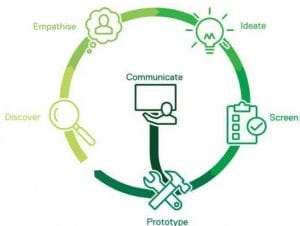Team Cuscus generated their design solution by following the Human-Centred Design Process. This consisted of six key steps; discover, empathise, ideate, screen, prototype and communicate.
 The Human-Centred Design Process forces the user to be impact-driven in the engineering of their solution while also ensuring that the solution is human-focussed. The cyclic nature of the process encourages one to reiterate steps multiple times to produce a higher quality, better-refined solution.
The Human-Centred Design Process forces the user to be impact-driven in the engineering of their solution while also ensuring that the solution is human-focussed. The cyclic nature of the process encourages one to reiterate steps multiple times to produce a higher quality, better-refined solution.
By initiating the process with ‘discover’, our team researched broadly to have a basic understanding of the environment and communities of the Cape York Peninsula. This was then condensed through the ‘empathise’ stage. This forced our team to consider our research of the history, people and their land concerning those who live in the Cape. This allowed us to better understand what issues most heavily impact the lives of locals, mainly in relation to the Cape’s Indigenous population. This required further discovery to complete effectively. These initial stages of the human-centred design process ensured that we worked towards producing a human-focused solution. By understanding the needs of the community, we were better prepared to produce relevant ideas for solutions.
From here, we ideated. We used various ideation tools including brainstorming, saturating and grouping the ideas from our brainstorming, and brainwriting. Due to not being able to meet in person with one another, our team’s ideation was completed online through shared documents and video chats. We had created a vast bank of ideas based on the previously discovered needs of the community. Upon requesting confirmation from our team mentor, we discovered that we had branched too far in our ideation. Many of our design solution ideas didn’t explicitly solve the issues described in EWB’s project opportunities. They were culled or altered and more ideas were needed.
From here we used SCAMPER, an ideation method where the user employs one or many of the various techniques to try and improve a solution or create a new one. We created an inventory of over twenty ideas to choose from.
To screen our ideation inventory, the team worked through a list of criteria that had been developed upon the EWB Design considerations and applied to each project idea. These design considerations were: technical feasibility, contextual appropriateness, social impact, economical impact, environmental impact, ethicality, cultural appropriateness and sustainability. By discussing and comparing the solution ideas to these design considerations, we eliminated the ideas that did not mirror the requirements of the criteria. This allowed us to highlight the ideas that were best suited for further development, resulting in the 5 design options. These were further researched and were:
- weed removal brush and signage
- self-operated vacuum system
- rock drainage catchment
- grey-water system to add to existing weed removal places
- mobile solar-powered bore water pump
These ideas were further researched then compared against a decision-making matrix.
Decision-Making Matrix:
| Criteria | Weighting | #1 | #2 | #3 | #4 | #5 |
| Cultural appropriateness of the design | 10% | 6 | 6 | 7 | 6 | 7 |
| Economic impact of the design | 20% | 8 | 6.5 | 7 | 6.5 | 8 |
| Environmental impact of the design | 20% | 6.5 | 7.5 | 8 | 8 | 8 |
| Ethical suitability of the design | 10% | 6 | 7 | 8 | 8 | 8 |
| Social suitability of the design | 15% | 7 | 7 | 7 | 7 | 7.5 |
| Sustainability of the design | 15% | 7 | 6 | 6.5 | 7 | 7 |
| Technical feasibility | 10% | 8 | 7 | 7 | 6.5 | 7 |
| Total | Sum to (100%) | 70% | 67.5% | 72.25% | 70.5% | 75.75% |
This allowed us to accurately discover which design was best suited to the communities.